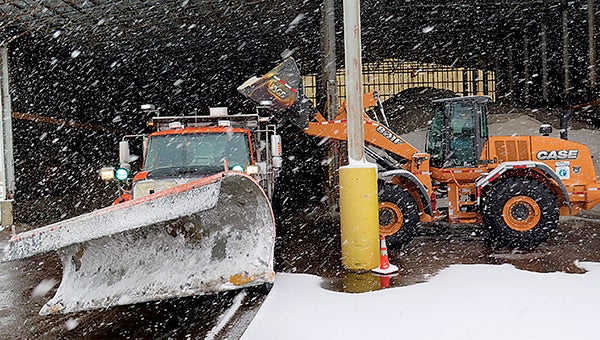State, cities try to apply science to their road-salt use
Published 10:36 am Thursday, February 4, 2016

A loader fills a plow with salt at MnDOT’s truck station in St. Paul on Tuesday. — Elizabeth Dunbar/MPR News
By Elizabeth Dunbar
MPR News/90.1
Scott Sippel is a plow driver for MnDOT, and this week’s storm was a perfect opportunity to see how he decides what to apply to the pavement.
“Right here I have my gauges,” he explained to a passenger on Tuesday. “I have my air temperature, says 36 here, and my road temperature is 34. It’s good to know if it’s going to freeze to the road or what.”
If it’s warm enough, crews can apply salty brine ahead of a storm. The liquid helps prevent the pavement from icing up and also helps reduce the amount of salt that might be needed after the snow starts falling.
Early in the afternoon on Tuesday, the snow was still coming down. So at first Sippel wasn’t applying salt to his route.
“If I go out and put material down while plowing,” he explained, there was a good chance “you’re going to come back over that road again and you’re just going to plow it off the road, so you’re wasting your salt.”
On the other hand, there are spots that need more salt, like interstate ramps.
“Sometimes like this we have compaction and it’ll take a little more to get rid of,” he said. “Pretty packed down from cars driving on it.”
Sippel goes through training every year aimed at teaching drivers how to optimize the amount of salt they’re putting on the road. Doing so helps the state save money and minimize the amount of salt that could reach lakes and streams.
“It’s more of a science than what it used to be,” said Craig Eldred, public services director for the city of Waconia.
Eldred, who has 20 years of experience in the industry, said MnDOT and cities like his are using real-time weather and road-condition data to help plow drivers make better decisions about how to treat the roads.
Keeping track of salt use year to year means always getting better, he said.
“If you have good data you can really be on the forefront and make some changes,” Eldred said.
It’s not just about lowering maintenance costs. Cutting back on salt is also good for the environment, because when it makes its way to lakes and rivers, as the pollutant chloride, it can harm fish and plants.
State officials consider about 80 bodies of water in the Twin Cities metro area too salty or at risk of being too salty. But they hope better training and technology will help plow drivers keep that number from rising.
Brooke Asleson of the Minnesota Pollution Control Agency pointed out that chloride can’t be removed from a lake.
“The only way for us to address this pollutant is through prevention,” said Asleson, a project manager in the watershed program at the MPCA.
She’ll be speaking Thursday at an annual road salt symposium — the 15th year environmental advocates have met with the road maintenance industry to find the right balance between treated roads and clean water.
This year, attendees will talk about climate change and will hear from University of Minnesota climatologist Mark Seeley about Minnesota’s warmer, shorter winters and wetter conditions. (Seeley can be heard regularly on MPR News.)
Asleson said the state will need to collect more data to know whether climate change will mean applying more or less road salt. It’s not as simple as applying more salt when there’s more snow.
“There’s not a direct correlation, because salting events are not any one weather condition,” Asleson said.
Besides snow, workers must contend with refreezing, black ice and frost. And with warmer winters, Minnesota might see more freeze-thaw events that make roads slick.
Despite the uncertainty, environmental advocates are pleased with the progress so far. The old method of “applying salt by gut feel” is a thing of the past, said Steve Woods, executive director of the Freshwater Society, which is organizing the road salt symposium.
“If you look back a couple decades, we were a lot more liberal with our use of salt,” he said. “It was being tossed around in a lot of places. I personally lost a quarter of a 1963 Chevy Bel Air to road salt.”





